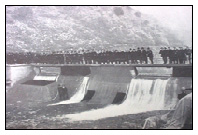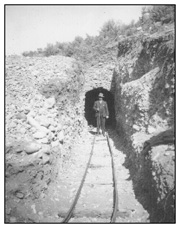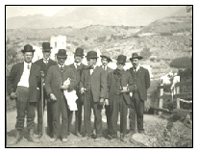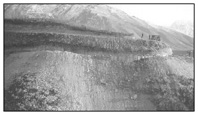The Big Cottonwood Conduit
By LeRoy W. Hooton, Jr.
January 25, 1999
|
One of the most important water projects of the early 20th century, the construction of the Big Cottonwood Conduit ushered in a new era of water development. On February 5, 1907 the conduit conveyed the waters of Big Cottonwood Creek to Salt Lake City. The diversion was made possible through an exchange of water similar to the City's successful exchange agreement with the Parleys Water Users in 1888. Both the Parleys and Big Cottonwood stream exchanges were accomplished in the same manner. The farmers exchanged their mountain water for a more dependable source of irrigation water from Utah Lake, delivered through the Jordan and Salt Lake City Canal. Starved for additional municipal quality water to serve a population of nearly 100,000 inhabitants, the City gained an invaluable source of drinking water. The exchange of waters was mutually beneficial to all.
|
No sooner had the Parleys exchange been completed with the construction of a reservoir at the mouth of the Parleys Canyon and pipeline than the City looked farther to the south for additional exchanges. On December 12, 1899, City Engineer Frank C. Kelsey submitted his "Water Supply Investigation, Preliminary Report on Big Cottonwood Creek" to the City Council.
Nearly 5-1/2 years after submitting Engineer Kelsey's preliminary report, the City entered into the first Big Cottonwood exchange agreement with the owners of the Hill Ditch on June 27, 1905, followed on the next day with the Big Ditch and Lower Canal farmers. The Big Cottonwood water supply was described in the Annual Report of the City Engineer for the year 1907, "as the largest of the several mountain streams in Salt Lake County, (and) its waters are always cold and pure."
In the early years, only farmers who were located below the Jordan and Salt Lake City Canal could exchange water. The higher bench farms could not be reached with Utah Lake exchange water until 1924, when Salt Lake City acquired rights in the East Jordan Canal, a higher diversion on the Jordan River. The East Jordan Canal was extended by the City from the Fort Union area northward to 2080 East 6200 South. At this location a pumping plant was constructed and a 30-inch wood stave pipeline constructed eastward to a point where today I-215 crosses over Big Cottonwood Creek (2900 East). By delivering exchange water higher on the creek, Salt Lake City was able to exchange waters with the other irrigation ditch owners and acquire nearly all the waters of Big Cottonwood Creek.
The conduit was designed to flow by gravity (not pressurized) and to carry 60.5 cubic feet per second of water. It traversed the eastern foothills, following the hydraulic gradient above Wasatch Blvd., a distance of 7.23 miles from the Big Cottonwood Creek diversion point to the mouth of Parleys Canyon. The water was then delivered into Salt Lake City's water distribution system through a 36-inch conduit to the Thirteenth East Reservoir (located at 1300 East First South). The cost of the Big Cottonwood Conduit was $427,000.
Gaining the right to divert the waters of Big Cottonwood was not without its problems. Shortly after diverting the water, the Progress Power Company secured an order from the Third District Court, ordering the City to desist diverting the waters during the winter (or non-irrigation) months. A compromise was struck, whereby Salt Lake City diverted only one-half the stream flow during the non-irrigation months; but shortly thereafter this dispute led to a lawsuit to quiet title of the water rights. Judge Morse
|
The decision was appealed and the final judgment was made by the Supreme Court on June 6, 1918.
With the construction of the Big Cottonwood Conduit, and the diversion of water in 1907, the City immediately began to explore sites for reservoirs within Big Cottonwood Canyon. The stream flows varied from season to season and were subject to droughts. Reservoirs able to store water during the spring run-off would provide valuable drinking water during the late summer months when the natural stream flows diminished. Like the farmers who preceded the City, nature alone could not provide a reliable water supply. According to the 1907 City Engineer's Report, "The most suitable (sites) for storage purposes are those in which are situated Lake Phoebe, Lake Mary, Lake Martha, Lake Catherine and the Twin Lakes…When converted they will be capable of holding considerable quantities of pure, sparking water and will increase and make more dependable the City's water supply." Subsequently, dams were built in 1917 to store the waters of Lake Mary - Phoebe and Twin Lakes. These water storage facilities are still in use today.
The importance of the Big Cottonwood water supply cannot be overstated. Today it provides about 22 percent of the water supply to 400,000 people in Salt Lake County and Salt Lake City. The water was treated near the diversion dam by screening and adding of chlorine from 1917 to 1957. In 1957, a modern conventional water treatment plant was constructed, and filters added in 1959. Today, watershed protection and modern water treatment processes provide drinking water meeting federal drinking water standards.
|
The City's pioneering effort at the turn of the 20th Century to convey the waters of Big Cottonwood Creek to the growing population center of Utah was another milestone in Salt Lake City's efforts to develop and deliver a dependable water supply to its citizens. As part of the early exchange agreements, Salt Lake City delivered culinary water to its exchange partners (farmers) on the lands once irrigated with the waters of Big Cottonwood Creek, thus opening this area to urban development. Today much of the farmland has disappeared replaced with subdivisions, malls, and other urban amenities. The waters of Big Cottonwood and other sources of supply now provide the entire area the gift of water in this community located at the edge of the Great Basin desert.
Information regarding this article can be directed by e-mail to: leroy.hooton@ci.slc.ut.us



